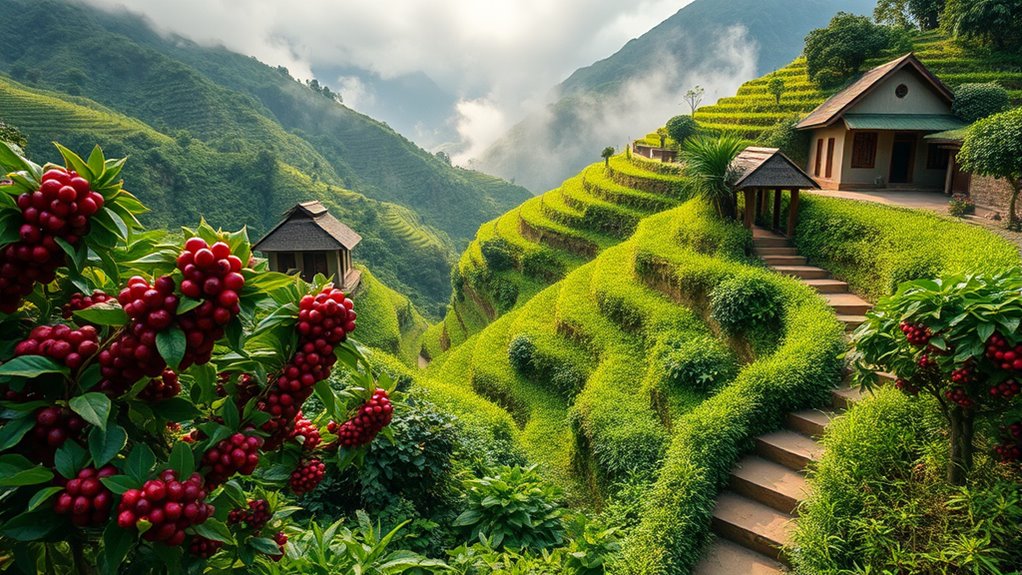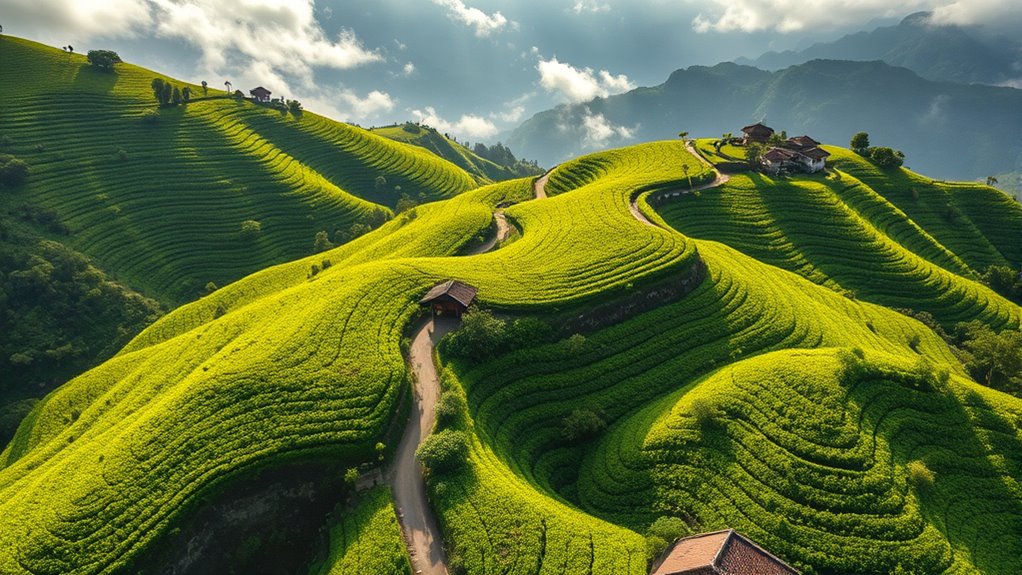You might be surprised to learn that countries like China and Thailand are emerging as exciting coffee regions, challenging traditional ideas of quality and flavor. In Yunnan and northern Thailand, farmers use sustainable practices that enhance the beans’ unique bright, floral, and fruity profiles. These unexpected areas prove that exceptional coffee can come from anywhere, shaped by environment and innovation. Keep exploring to discover more about how these surprising regions are transforming the coffee world.
Key Takeaways
- Countries like China and Thailand are emerging as notable coffee producers with unique flavor profiles.
- Yunnan, China, offers bright, citrusy beans due to high-altitude, misty conditions.
- Thai regions such as Chiang Mai focus on sustainable practices, producing floral and tropical-flavored coffees.
- These regions challenge traditional coffee origins, showcasing diverse environments and innovative cultivation methods.
- Other unexpected areas like Vietnam and Honduras blend tradition with sustainability to create distinctive coffee experiences.

Have you ever wondered where some of the world’s most surprising coffee regions are? You might assume that coffee only thrives in familiar places like Brazil or Ethiopia, but unexpected areas are starting to make a name for themselves. Countries like China and Thailand, long known for their diverse agriculture, are now gaining recognition for producing unique coffee beans that challenge traditional notions of flavor and quality. These regions are experimenting with sustainable farming practices, which not only protect their environment but also influence the flavor profiles of their coffees. When you taste coffee from these places, you’ll notice distinct notes that reflect their climate, soil, and cultivation methods.
Surprising coffee regions like China and Thailand produce unique beans with distinct flavors influenced by sustainable practices.
In China, particularly in Yunnan Province, coffee cultivation is relatively new but rapidly growing. The region’s high-altitude terrain and misty mornings create ideal conditions for growing coffee, which results in beans with bright, vibrant acidity and complex flavor profiles. Farmers in China are increasingly adopting sustainable farming techniques, such as organic fertilization and water conservation, to ensure the land remains healthy for future harvests. This commitment to sustainability enhances the quality of the coffee and allows you to enjoy nuanced flavors like citrus, floral, and berry notes that are uncommon in more traditional coffee regions. Chinese coffee producers are also experimenting with processing methods, which further diversify flavor profiles, giving you a broader range of tasting experiences. As these practices become more widespread, they serve as a model for sustainable coffee cultivation worldwide.
Thailand’s coffee scene is similarly surprising. The northern regions, like Chiang Mai and Chiang Rai, are producing specialty coffees that showcase the country’s rich biodiversity. Here, smallholder farmers are embracing sustainable farming practices to preserve the environment while cultivating high-quality beans. These coffees often feature bright, clean flavors with hints of tropical fruits, floral undertones, and sometimes even spicy notes. The emphasis on sustainable practices, such as shade-grown coffee and minimal chemical use, helps maintain the region’s ecological balance and contributes to the distinctive flavor profiles that set Thai coffee apart. As the Thai coffee industry continues to innovate, more people are discovering its potential to deliver unique, vibrant cups that reflect the region’s natural richness.
Beyond China and Thailand, other unlikely regions are also making waves. Places like Vietnam, Honduras, and even parts of Central America are expanding their coffee horizons, blending traditional methods with sustainable farming to produce distinctive beans. Each of these regions offers a fresh perspective on coffee, proving that amazing flavor profiles can come from unexpected corners of the world. So next time you reach for your favorite brew, remember that some of the most memorable coffees might be hiding in places you never imagined, shaped by sustainable farming and bursting with unique flavor notes.
Frequently Asked Questions
What Unique Coffee Flavors Are Emerging From These Regions?
When exploring new coffee regions, you’re likely to encounter exciting flavor innovation and tasting profiles. These areas offer unique notes like floral, fruity, and spicy hints, thanks to diverse climates and processing methods. You might taste bright citrus, exotic spices, or even floral aromas that stand out from traditional coffees. Embracing these emerging flavors enriches your coffee experience, broadening your palate with distinctive profiles that reflect regional uniqueness and innovative cultivation.
How Do Climate Changes Affect Coffee Cultivation in New Regions?
Climate variability directly impacts coffee cultivation by altering temperature and rainfall patterns, making it harder to predict ideal growing conditions. You need to focus on altitude adaptation since higher elevations can buffer some climate effects, providing cooler temperatures that support coffee growth. As climate changes, you’ll have to adjust farming practices, select resilient varieties, and possibly shift cultivation to more suitable altitudes to maintain quality and yields in new regions.
What Challenges Do These Regions Face in Establishing Coffee Industries?
You face challenges establishing coffee industries in new regions, including developing robust export infrastructure and managing socioeconomic impacts. Limited experience and resources can hinder production and market access, while local communities may resist change or lack the skills needed. Additionally, building sustainable practices and infrastructure takes time and investment, but overcoming these obstacles is essential for creating a thriving coffee industry that benefits local economies and integrates into global markets.
Are Local Traditions Influencing Coffee Processing Methods?
Think of coffee processing like a dance; local traditions set the rhythm. You’ll find cultural influence shaping methods, blending age-old techniques with processing innovations. In regions like China and Thailand, farmers often incorporate traditional practices, such as unique fermentation or drying styles, that reflect their cultural identity. These traditions influence the final flavor, adding a distinctive touch that only local customs can provide, enriching the global coffee scene with diversity.
How Do These Regions Compete With Traditional Coffee-Producing Countries?
You see, these regions compete by leveraging regional branding to highlight unique flavors and stories, attracting niche markets. They also adopt innovative export strategies, like forming partnerships and exploring new markets, to boost visibility and sales. By emphasizing their distinct cultural influences and quality, they carve out a space in the global coffee scene, challenging traditional producers and appealing to consumers seeking novel, authentic experiences.
Conclusion
As you explore these unexpected coffee regions, remember they’re like hidden gems waiting to be uncovered. Just as a seed finds new soil to grow, coffee’s journey now extends beyond traditional borders, symbolizing resilience and adaptability. Embrace these surprises, for they remind us that innovation often begins where we least expect. Keep your curiosity brewing, and you’ll discover that even the most unlikely places can yield rich, new flavors—proof that greatness can bloom anywhere.









